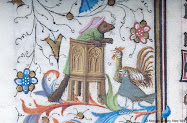I was thrilled to discover this rather dashing equestrian statue of Edward, the Black Prince (father of Richard II) outside the railway station in Leeds.
But take a closer look at the dedication:
Really?? Edward was the heroic 'upholder of the rights of the people' in the Good Parliament? To my knowledge, the Black Prince was in fact mouldering away on his deathbed somewhere in London while that parliament was sitting, and he was in no condition to do any grand posturing for 'the rights of the people' even had he wanted to. His real achievement was to get his brother, John of Gaunt, to publicly recognise his 9-year-old son Richard as the heir to Edward III's throne (Edward III himself also having one foot in the grave by this point).
This statue certainly plays fast and loose with the medieval past (and no doubt has been implicated in the odd less-than-accurate history essay written by Leeds schoolchildren). It was erected in the late 19th century (a date in the 1890s rings a bell, though I can't remember exactly when) and I would love to know a bit more about the context in which it was produced, and in which its extraordinarily inaccurate dedication was considered apt. Anyone the wiser?
Monday, July 23, 2012
Subscribe to:
Post Comments (Atom)






4 comments:
I didn't have time to 'stop and stare' at this statue when dashing for a train at Leeds. I do usually have a peek, just to find out who is represented with horse leg up or all four feet planted down. Would I have realised the error of its dedication. At the time, probably not. Having an interest in history, it is almost certain, I would have uncovered some of the irregularities you have pointed to. I sincerely hope that Medieval history doesn't figure too often in the English GCE and A level papers on the basis of this mis-information. We can only hope that it is corrected in the school libraries and the classrooms.
We often talk about seeing chunks of history being airbrushed out of a society, when we travel abroad. This beats that, by perfidious Albion actually re-framing it.
Sorry I am unable to enlighten you with your queries, but thank you for enlightening me!
Clever, really, placing the statue outside a station where most people are rushing without time to stop and question.
Next time you're in Britain do drop by for a drink. I could show you sites of a burning or two (just up the road in Oxford) and also where King Alfred squabbled with the Danes.
Now you're talking! When I eventually get to Oxford again, I shall keep a look out for our commemorated barbaric histories.
I this tempting enough for Barvardess do you think?
;)
Huh - I never really thought about the *placement* of the statue in terms of communicating its dubious message. I suppose that back in the late 1800s, outside the railway station would have been a prime spot in terms of visibility, prestige etc. but these days, it's just one more thing to run past on the way to the train. And I would love to see some of your local historical haunts. Perhaps next time I go to the IMC...
Post a Comment